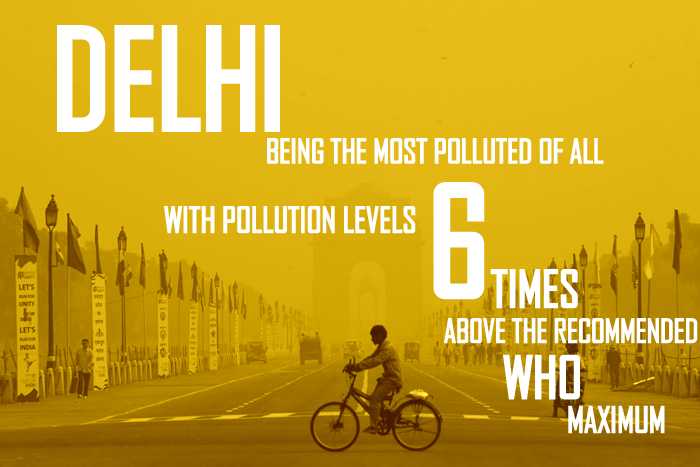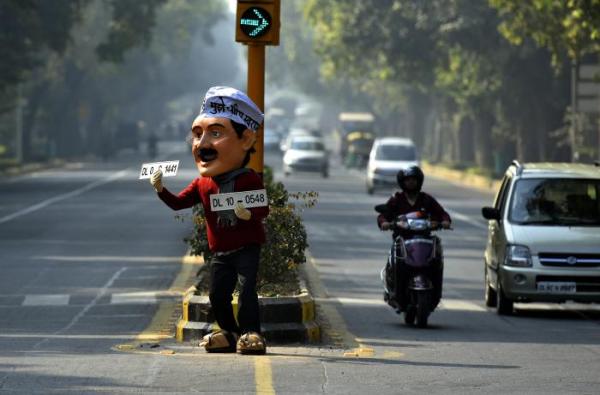
- In its 70-point action plan released in 2015, the Aam Aadmi Party vowed to reduce pollution in the National Capital.
- In August 2015, the party launched its first comprehensive programme to fight pollution in Delhi.
- The Kejriwal government was applauded for its Odd-Even formula which was implemented for the first time in India.
- But did the party meet the expectations of people to make Delhi pollution-free?
In February last year, the Arvind Kejriwal-led Aam Aadmi Party had released a manifesto with a '70-point action plan' - in a bid to comeback to power after its failed 49-day stint in 2014. Among a number of ambitious projects, the plan included the AAP's vow to reduce pollution in the National Capital.
A 2014 World Health Organisation study had named New Delhi as the world's most polluted city. Experts cited air pollution as the cause of thousands of deaths.
Also read: Shocker: not just Delhi, India has 10 of the world's 15 most polluted cities

Photo: Salma Rehman/Catch News.
The year 2015 was, therefore, a litmus test for the AAP government to prove its commitments towards battling the rampant pollution levels in the city.
A year of pollution
Five months after taking charge, the AAP government in August 2015 launched its first comprehensive and high-octane 'public programme' to address Delhi's pollution woes.
An initial target was to plant 14 lakh saplings across the national capital during the year 2015-16 - under which drives were carried out by certain ministries across the city.
Taking it to the roads, car-free days were also organised.
However, it was not until December that the government began to clamp down on environmental violators - slamming challans on waste burning, suspending the operations of Bardarpur and Rajghat power plants and launching an app to help people report violations of norms against pollution.
The AAP government's trump card was the Odd-Even formula for vehicles - the first of its kind in India. Taking a cue from cities like Mexico, Bogota, Paris and the pollution-choked Beijing, Delhi too underwent a 15-day trial run of the formula this year. Under the scheme, cars with number plates ending in even and odd numbers would ply on alternate days.
Also read: What Bogota, Mexico City, Beijing's experiences tell us about Delhi's even-odd policy
How did the government fare?
The Odd-Even policy, followed religiously even by the Chief Justice TS Thakur - despite exemption - was a hit.

File Photo
Appreciating the scheme, research bodies like The Energy and Resources Institute (TERI) and the Centre for Science and Environment (CSE) said that the formula significantly reduced levels of PM 2.5 in the capital. Additional benefits included reduced road congestion and less fuel usage.
Also read: What PM2.5 pollution really means. And what it's doing to you and your kids
#Odd-even is necessary. Delhites just can't cop out: Anumita Roy Chowdhury
Moreover, the rule was closely followed by the citizens of Delhi - another thumbs up.
Long term strategy
However Anumita Roy Chowdhury, executive director, research and advocacy with the Centre for Science and Environment believes that it is time for the government to come up with a long-term policy rather than being dependent on emergency measures. She said:
"We appreciate odd-even formula but the government should sustain its gains and need to roll out a stringent monitoring and compliance policy for every pollution source which will help the city in the long run".
Chowdhury insisted on the need to scale up the integrated transport system - including the metro, bus, autos and taxis. She also stressed on infrastructural space for cycling and pedestrians.
"The government needs to bring in a parking restraint policy defining proper parking spaces. Further there should be well-drafted taxation policies for personal vehicles (where personal vehicles owner pay more tax than public vehicles) and fuels like diesel".
In 2015, the Delhi government challaned a number of metro construction sites for adding to the dust in the city. But according to Chowdhury, more robust guidelines should be issued for construction sites for adopting a dust control system.
As far as challans on burning waste is concerned, Chowdhury said the government should create a proper facility for collection, composting and recycling of the such waste.
For countering paddy burning - a seasonal problem - Chowdhury suggested that the government must coordinate with neighbouring states.
"States like Punjab have made it illegal but the states should further subsidise the technology which helps to mix paddy with the soil for fertilisation so that farmer reuse the paddy instead of burning it."
Emergency strategy
Increasing pollution levels in the later half of the 2015 were attributed to the 'notorious' weather of the city. However, Dr Gufran Beig, project director of SAFAR at IITM says that the weather manipulates the pollutants which are already present in the atmosphere. Beig said:
"The city requires a proper monitoring system which can predict the pollutant levels over a certain time period. Such reading can therefore be integrated with weather patterns and emergency measures can be taken accordingly".
On a technical note, Beig suggested that the relative contribution of pollutants from sources should be realised and that measures should be taken accordingly.
First published: 1 February 2016, 3:56 IST


![BJP's Kapil Mishra recreates Shankar Mahadevan’s ‘Breathless’ song to highlight Delhi pollution [WATCH] BJP's Kapil Mishra recreates Shankar Mahadevan’s ‘Breathless’ song to highlight Delhi pollution [WATCH]](https://images.catchnews.com/upload/2022/11/03/kapil-mishra_240884_300x172.png)

![Anupam Kher shares pictures of his toned body on 67th birthday [MUST SEE] Anupam Kher shares pictures of his toned body on 67th birthday [MUST SEE]](https://images.catchnews.com/upload/2022/03/07/Anupam_kher_231145_300x172.jpg)






